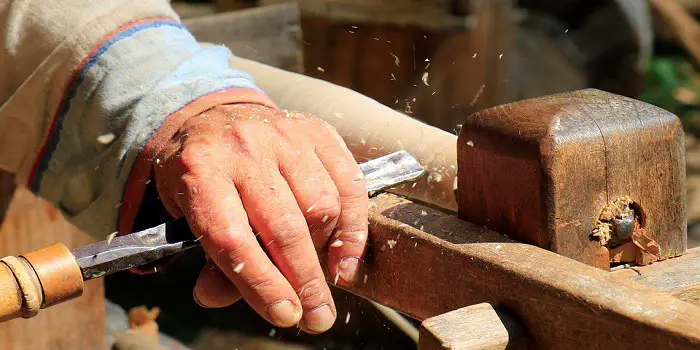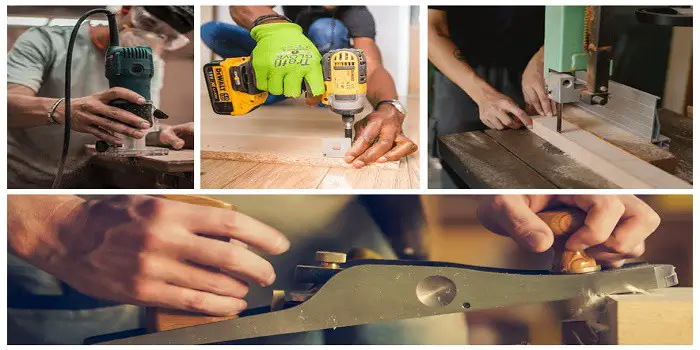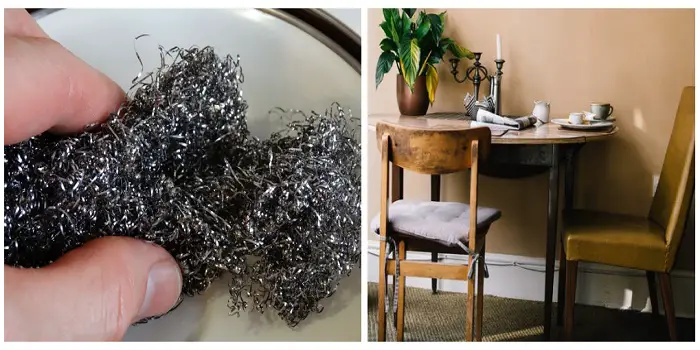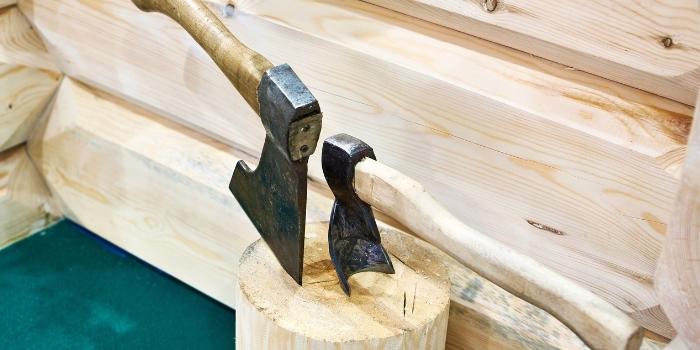
An adze is a tool similar to an axe, basically a metal blade that is attached to a handle. It has the appearance of a pickaxe, with one notable exception which is the horizontal blade is normally curved instead of straight. Plus, the blade itself may be straight or curved into a U-shape for carving out pieces of wood.
The adze has proven to be quite a versatile tool because it’s found useful in smoothing, carving, and shaping wood. It’s also used for hollowing out wood to create bowls, troughs, canoes, and chair seats.
Adze tool is also quite useful for flattening the surfaces of timber to create beams. You can carve, sculpt, and even create bends in wood using adzes.
A Bit of History
The adze has a long history, going back many centuries.
It has even been mentioned in popular myths, such as in Polynesia where Tane, the god of the trees, taught the people how to combine a sharpened stone onto a wooden branch which created the first adze.
The modern adze is believed to have been created during the Iron Age, and its basic design has changed relatively little since.
Adzes were often used to smooth out the wood, although today, the plane is the tool that most people use for that task.
An adze is still a popular tool for use on timber and large logs to remove bark and shape them to their desired outcome.
In fact, many beams that are used in the construction of elegant homes will often have the marks of an adze present.
This is because the marks make the beams look even older and provide a unique touch that makes the home itself more prominent.
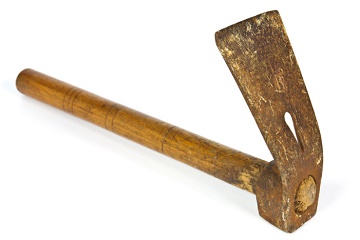
What Are Adzes Made Of?
Although the adze started out as a sharpened stone that was attached to a wooden handle, the blade is now most commonly made of steel.
The head where the blade resides is thick and firm enough to withstand many years of use.
Plus, it can be sharpened relatively easily with the right tools.
The high carbon steel heads are created using a combination of heating, cooling, and compression that provides them with considerable strength.
Steel often has other materials added to the forging process, that includes aluminum, boron, and niobium.
The result is a dense structure that resists breaking down even after repeated use.
The handle may be made of fiberglass, which is strong and lightweight, but they are not as common as wooden handles.
The most popular material used to make handles is hickory.
Hickory is strong, hard, and light which can absorb the impacts of the blade repeatedly. Plus, hickory replacement handles are widely available.
Other wood that is commonly used is cherry and ash. However, these woods are not as durable or as popular as hickory.
However, while you can find many adzes that have been manufactured, it is still a popular tool for many to create on their own.
How Does a Typical Adze Work?
If you imagine a chisel that has a long handle and is designed to cut into the material by being swung, then you have an adze.
This tool chips away at the wood one small piece at a time.
The more you swing, the more material is removed, and the more the wood becomes the shape that you want.
You can make wood smooth, hollow out the wood, or simply remove the bark.
It does take practice to perfect the swing necessary to properly use an adze.
Those who have considerable skill can place a pencil between their feet and sharpen it with this tool.
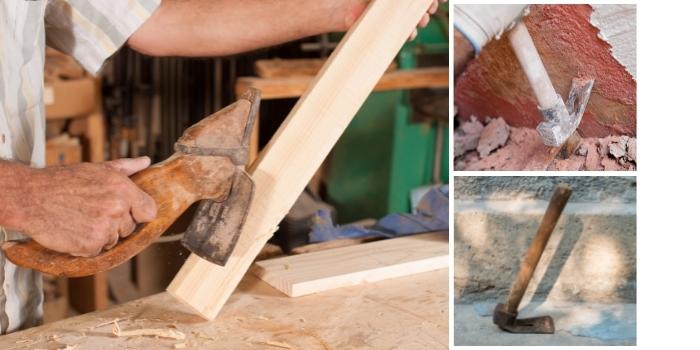
What are the Different Types of Adzes?
There are different types of adzes available based on the curve of the blade, the shape, and the length of the handle.
1- Boston – The Boston adze is primarily used for demolition work. This type of adze has a blunt blade and is often used by firefighters to break through doors.
2- Carpenter adze – This is a heavy version of the adze used to shave wood. Because of its weight, it is easy to swing and bite into the wood. The blade is generally flat, so it can shave off even pieces.
The one downside is that it is difficult to use this type of adze unless the wood is positioned on the floor to provide enough swing.
3- D-Handle – They are primarily designed to be used in tight areas where swinging an adze is not practical. Because of the unique D-shape of the handle, you do not need to swing this adze to use it.
Just hold the D-shaped handle to point the blade downwards. Then carve away using a gouging motion.
4- Hand adze – This adze has a short handle and is designed to primarily be used with one hand in small or cramped spaces that do not allow for longer adze handles to be used.
Such an adze is often used by coopers or barrel makers to smooth out the tops of barrels. However, you can also find hand adzes that have a lipped blade that can be used to hollow out bowls.
5- Foot adze – This type of adze has a long handle in which both hands must be used. You straddle a large piece of wood and then use the foot adze to shape it.
There are types of foot adzes that can be used at higher levels, such as at the chest or even the head. Using them is relatively easy. But for beginners, you may need a lot of practice to master the technique and get accurate results.
6- Ice adze – As the name implies, this adze is primarily used to cut or dig into the ice. They have wide, flat heads and can be used to chip or remove ice or snow from slopes.
7- Lipped – These are U-shaped adze tools designed more to hollow out wood than to shave it smooth. They are similar to the shipwright version in that they are relatively lightweight.
8- Pocket – Small enough to fit into your pocket, this type of adze is great for camping when you need to shape wood outdoors.
9- Railroad – This version has an elongated head designed to allow the blade to come into contact with the material at the earliest possible point. It was believed that such a contact point would reduce the stress on the handle.
10- Shipwright – This adze is distinguished by its flared blade, which lets you shave off wider areas of the wood. They are relatively lightweight, which makes them easier to use over long periods.
There is also the two-handed adze with a long handle designed for use on large timber.
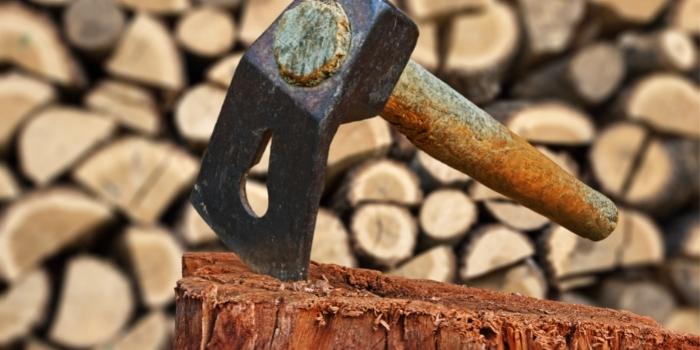
How to Choose an Adze Tool for Your Project?
If you have not used an adze much, then you might think that all of them are alike.
However, while the differences are subtle, they are quite important considering the jobs that they must accomplish.
This is why choosing the right one is important.
What follows are the main areas you should focus on when selecting an adze. This will help you get the right one for your project.
a) Length, Weight, Width, and Thickness
These are the basic criteria for choosing an adze.
The length should be long enough for you to comfortably swing into the wood.
The length of the adze is measured from the top of the head to the bottom of the handle. This means that you will want the adze to be long enough to comfortably swing but not too long or short, which may cause you to miss.
While it may seem more logical to go with a lighter weight, the truth is that the more weight in the blade present, the easier it will cut into the wood.
Of course, the adze should not be so heavy that you cannot control the swing. But the additional weight on the blade will make the swing easier and more effective.
Consider that you may be able to add additional weights just below the blade to increase the cutting effect.
The width refers to the width of the blade. Most adze blades are from ½” up to 5 ½”, with each size going up a half-inch.
This is one of the most important aspects to get right. As the wider the blade, the larger the surface area will be cleared.
The thickness of the blade may be the least important aspect of the adze. But it is still worth considering. This is because the blade thickness is measured at the thickest part, which is generally right before it gets to the handle.
The thicker the blade, the heavier it will be. However, if the thickness is beyond a certain level, such as 3/8ths”, then it should be thick enough to last a long time.
b) Blade Angle
Perhaps the most important aspect of buying an adze is the angle of the blade.
You’ll notice that there are different angles available, and this is because of the swing of the tool.
Ideally, you want the blade to be angled in such a manner that it creates a perfect circle as you swing into the wood.
The edge of the blade should be in line with the arc that you swing the adze.
A proper angle means that your swing should get a smooth cut from the adze each and every time.
If the angle is too shallow, the blade may skip off the surface at angles that you may not be able to predict.
And while a proper swing can lower the chances of injury, it can happen if the blade skips off the wood and towards you.
Too steep an angle, and you will not get a smooth cut. Instead, you are likely to get a deep, jagged cut that does not remove the wood.
This is why most blade angles are from 45 to 60 degrees. If you can test the adze, do so to find out which angle works best for your needs.
c) Coating
This one is relatively easy since most adze blades have a black oxide coating. This helps to prevent rust and is easy to clean and maintain.
The very thin coating not only looks neat and tidy but is also strong and durable.
Black oxide also is cheaper to apply than many other industrial-standard coatings, such as zinc plating.
d) Handle
You will need the handle to be made of a material that is strong, absorbs impacts well, and is relatively lightweight for easy handling.
Of the many kinds of wood used to create handles, hickory is arguably the best because it has all the proper attributes.
Plus, replacement hickory handles are relatively easy to find, so you can get a spare one quickly in case the worst should happen to your current adze handle.
e) Sweep
Finally, the sweep is the type of gouge that the blade will make into the wood.
The adze sweeps run from flat to U-shaped which numerically are one to eleven respectively. The lower the number, the flatter the blade.
And that is what you need to know when purchasing an adze. Know your project and then choose the right adze for the job.
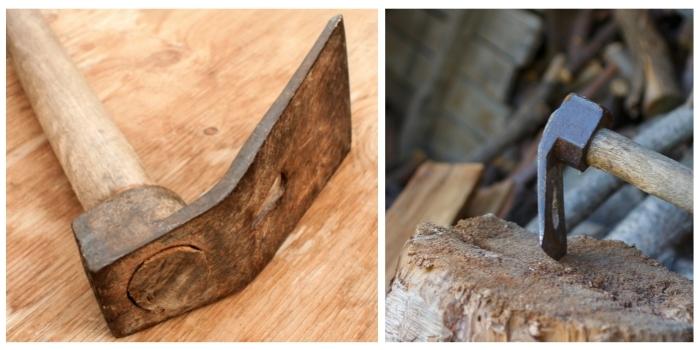
Adze: Maintenance, Care & Sharpening Tips for the Tool
As with any tool, the adze needs proper care and maintenance if you want it to last.
What follows are a few tips that will help you take care of the adze properly.
Handles
Adze handles are made from strong materials, often hickory.
But when exposed to the elements or moisture for a long time, they can become damaged. Wood can swell and crack when exposed to too much moisture.
While too little moisture can cause the wood to shrink and loosen the connection of the handle to the blade.
If the handle of the adze has been weathered, it will need to be sanded and oiled.
- Start by scraping off the dirt and debris with a stiff brush
- Then wipe it down with a damp cloth
- Add a coating of linseed oil that has been boiled
- Rub the oil into the adze handle and let it dry
- Apply a second coat and let it dry as well
The oil will seep into the handle and provide a layer of protection while trapping enough moisture inside to keep the wood strong.
If you have an adze with a fiberglass handle, be sure to keep it out of the sunlight when not in use.
Otherwise, the UV rays of the sun will cause the fiberglass to become brittle.
If the handle becomes too damaged, you can always replace them. Hickory handles are relatively easy to find.
Head
The head of the adze stays on the handle thanks to friction.
The head can be removed from the handle by taking away the wedge at the top on wooden versions, then striking the head, so it pops off.
Or you can bump the top of the handle on the ground, which should cause the head to come loose.
The main enemy of the head is rust.
So, you will want to inspect the entire head area to see if any rust has formed. An angle grinder can be used to remove any rust buildup on the metal.
Simply remove all the rust until you can see the metal underneath.
Inspect the blade for any dings or nicks. It should be sharpened under such circumstances.
As with any blade, keeping it sharp will keep the cutting accurate and easier to control.
So, when and how should you sharpen a blunt adze?
You should sharpen the adze when you notice any nicks or dings in the blade.
Prep
To do the sharpening, you will need a grinder such as an angle grinder.
A 100-grit grinding wheel is good enough to sharpen most adze blades. But check with the manufacturer for a recommended grit.
Secure the blade in place using a vice. Then apply the angle grinder to the blade.
If the adze has an outside or inside bevel, ensure that you are grinding in the right spot.
It helps to use a black marker to cover the area that needs grinding. Once it has been removed, the blade should be sharp.
Sharpen
For grinders, move the blade across the grinder to ensure it sharpens evenly.
When using an angle grinder, move it across the blade so that it sharpens evenly. A lipped adze will require you to turn the blade or grinder to match the curve of the blade.
For lipped adze blades, if you are sharpening on the inside, you may be able to rest the handle against the safety guard.
This will help you control the grinding process so you are more accurate with the sharpening.
Of course, you’ll want to check the guard to see if this is possible. Otherwise, you might damage the handle.
Once the black marker you have placed on the edge of the blade is gone, it should be sharpened.
Inspection
Inspect the blade under a strong enough light to see everything.
If you see any burrs on edge, that will need to be removed. Burrs are flakes of metal that have not fully detached during the sharpening process.
So, you will need to run the reverse side of the blade on the buffer wheel of your grinder.
This is because a burr has folded back on itself to make the normal sharpening process not work.
You’ll want to repeat the process until the burrs are all gone.
Check the blade until you see that everything is smooth. Once it is, then you can use it on wood.
Final Thoughts
An adz is a tool with arched blades that are perpendicular to the handle, similar to an axe.
Typically it was a Stone Age era tool that has been used for millennia.
The tool has gone through many changes and modifications in terms of usage and form as time went on.
As a result, it is still utilized all around the world. Presently it’s used in gardening and hand woodworking for shaping wood, among various other things.

Hi, I am Mark Garner a professional carpenter, woodworker, and DIY painter. I live in the small city of Peoria, Arizona as a semi-retired woodworker. I have started this blog with a simple motive to help you with my wood experience in this sector. If you like to know more about what I love doing and how it all got started, you can check more about me here.


